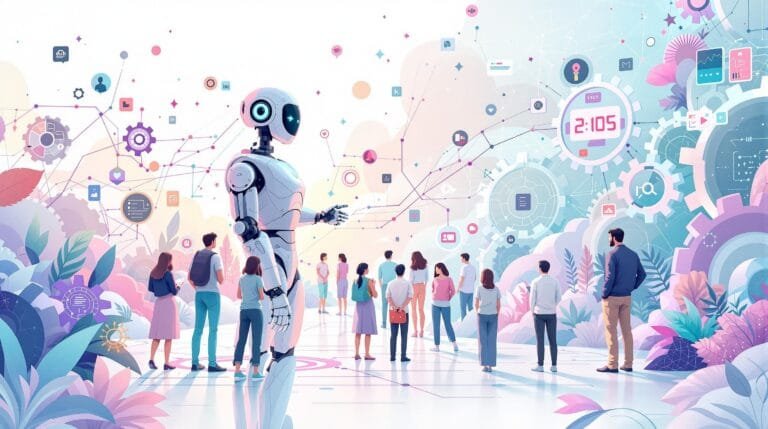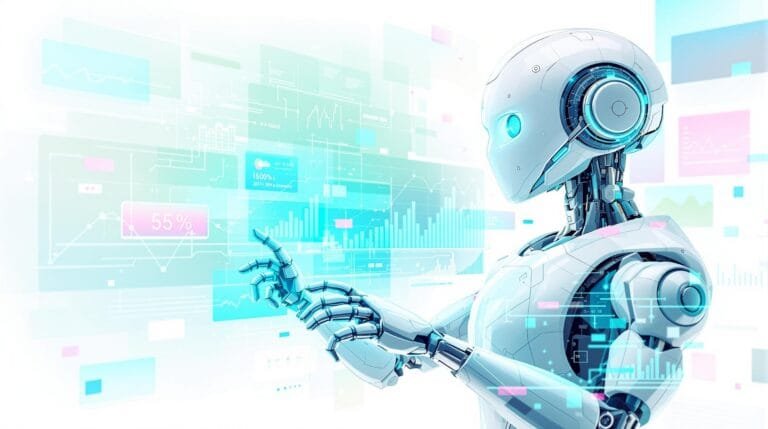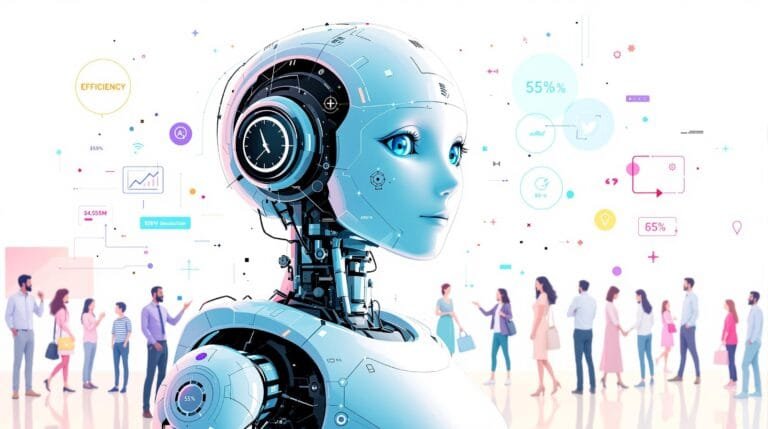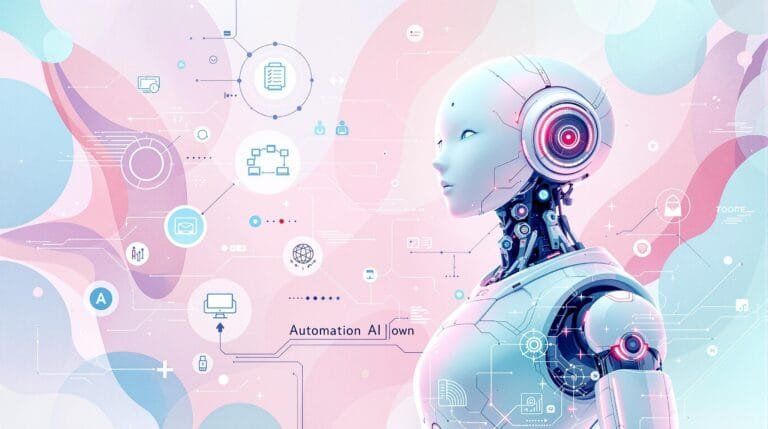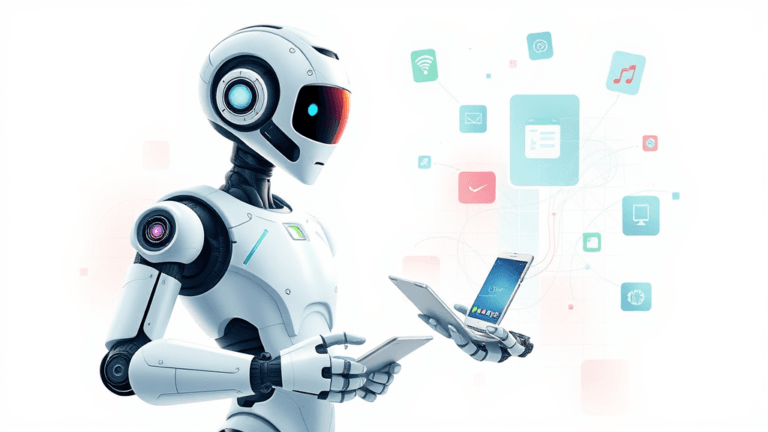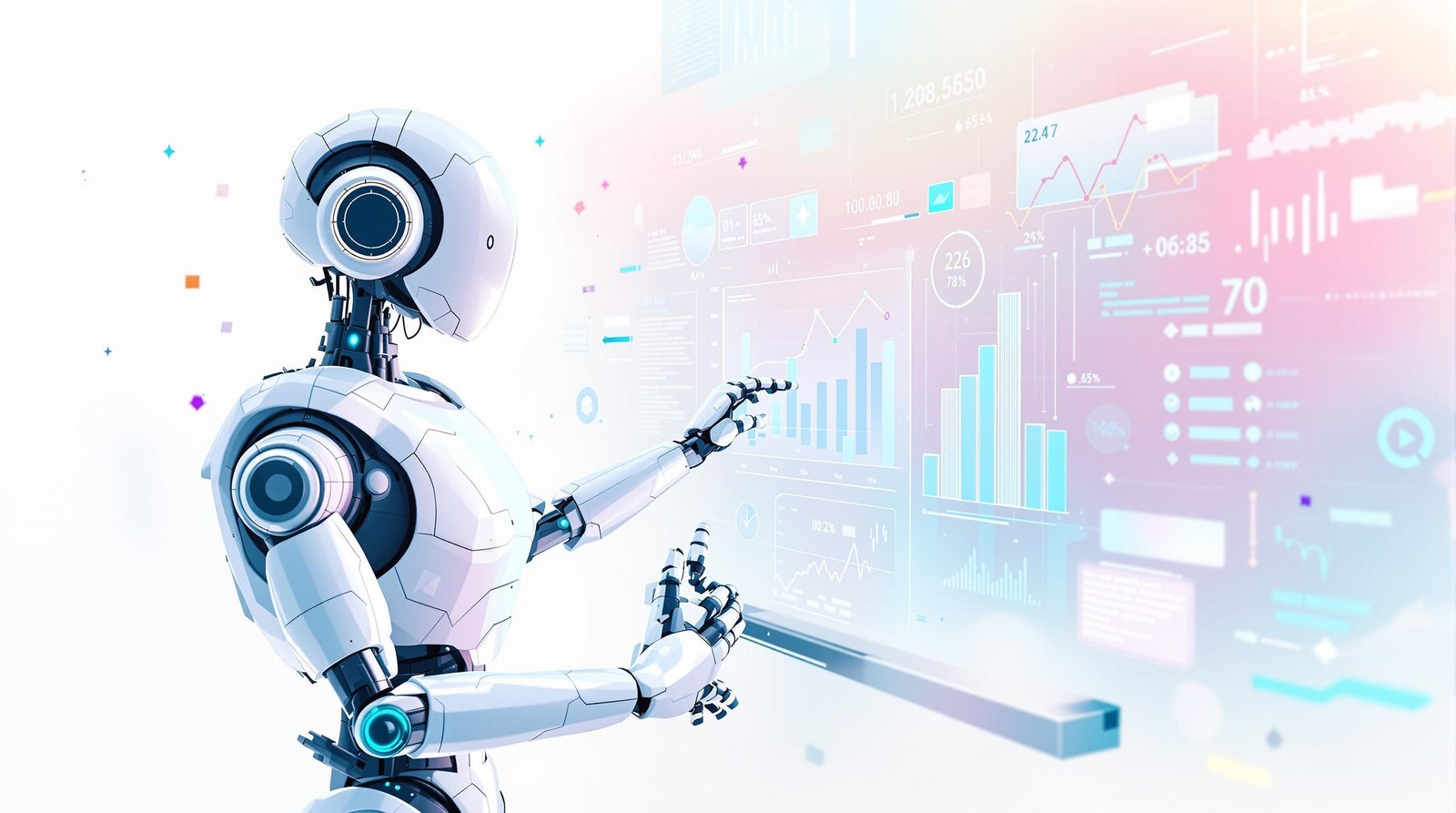
AI Automation Software for Business Success
Estimated reading time: 10 minutes
Table of Contents
- Understanding AI Automation Software
- Benefits of AI Automation for Business
- Types of AI Automation Services
- Choosing the Right AI Automation Software
- Implementing AI Automation in Your Business
- Best Practices for Implementing AI Automation Services
Imagine a world where your business operates 24/7 without coffee breaks, instantly spots errors in spreadsheets, and delights customers with lightning-fast responses. That’s not fantasy—it’s the reality for companies using AI automation software. In fact, 89% of organizations believe AI tools will help them grow revenue, boost efficiency, and improve customer experiences [Quixl Blog]. Whether you’re managing a neighborhood bakery or a global tech firm, AI automation might just be the silent teammate your business needs. Let’s explore how this technology works, its benefits, and how to implement it without breaking a sweat. How AI Can Save Your Business Time And Money Through Automation
Understanding AI Automation Software
What Is AI Automation Software?
AI automation software combines artificial intelligence (like machine learning and natural language processing) with automation to streamline tasks. Think of it as a digital assistant that not only follows instructions but also learns from patterns and adapts over time. For example, it can process invoices, answer customer queries, or analyze sales data—all without human intervention.
These systems handle everything from simple workflows (automating email responses) to complex decisions (predicting inventory needs). They’re like a Swiss Army knife for modern businesses, equipped with tools for every scenario. AI Automation Services Game Changer
How AI Technology Enhances Operational Efficiency
Why are companies racing to adopt AI technology for businesses? Let’s break it down:
- Speed & Accuracy: AI crunches numbers faster than any human, reducing errors in tasks like payroll or data entry.
- 24/7 Availability: No sick days, no fatigue—just consistent performance.
- Adaptability: Machine learning lets these tools evolve with your business, improving their performance over time.
- Data-Driven Insights: They turn raw data into actionable advice, like spotting a sales trend you might’ve missed.
A manufacturing client recently told me, “Our AI system cut production delays by 40% by predicting machine failures. It’s like having a crystal ball!” [Quixl Blog].
Benefits of AI Automation for Business
Increased Efficiency and Productivity
Full AI automation lets teams focus on creative tasks instead of repetitive ones. Imagine your staff spending less time on invoices and more on brainstorming growth strategies. AI handles the grunt work, whether it’s sorting customer inquiries or updating CRM entries. Full AI Automation Business Transform
Cost Reduction
By automating mundane tasks, businesses save on labor costs and reduce errors that lead to financial losses. For instance, AI-powered data entry tools can process 1,000 invoices in the time it takes a human to do ten [Quixl Blog].
Improved Accuracy
Human error costs U.S. businesses billions annually. AI-powered business solutions minimize mistakes in areas like financial reporting or compliance checks. One healthcare provider slashed prescription errors by 90% using AI verification tools. AI Powered Phone Support Benefits
Enhanced Scalability
AI automation for business lets you handle a spike in orders or customer requests without hiring temp workers. During last year’s holiday rush, an e-commerce client used chatbots to manage 5x more inquiries without adding staff. AI Automation For Business Success
Faster Decision-Making
AI analyzes mountains of data in seconds. A retail chain used predictive analytics to adjust pricing in real time, boosting margins by 12% [YouTube Video].
Improved Customer Experience
AI-powered business solutions like chatbots and personalized recommendations keep customers happy. Zendesk reports that 70% of buyers spend more with brands offering seamless service [Zendesk Blog]. How Can AI Help Business
Types of AI Automation Services
Robotic Process Automation (RPA)
RPA automates repetitive tasks like data entry or form processing. It’s the “digital workforce” handling rule-based chores—no coffee breaks required.
Intelligent Document Processing
AI extracts data from invoices, contracts, or emails, turning unstructured info into usable datasets. Legal firms use this to review contracts 10x faster. AI Customer Service Agent Revolution
Conversational AI
Chatbots and virtual assistants answer FAQs, book appointments, or troubleshoot issues. One airline reduced call center volume by 35% using AI chatbots [Zendesk Blog].
Predictive Analytics
AI forecasts trends, from sales spikes to equipment failures. A farm equipment dealer used this to optimize inventory, cutting storage costs by 20%.
Machine Learning Operations (MLOps)
MLOps automates the deployment of AI models. Think of it as an assembly line for machine learning, ensuring models stay accurate over time [YouTube Video].
Customized AI Solutions vs. Tailored Automation Systems
| Solution Type | Best For | Example |
|---|---|---|
| Customized AI Solutions | Unique workflows (e.g., niche manufacturing) | A brewery using AI to optimize recipes |
| Tailored Automation Systems | Common tasks (e.g., HR onboarding) | Off-the-shelf payroll automation |
Choosing the Right AI Automation Software
Key Features to Prioritize
| Feature | Why It Matters |
|---|---|
| Scalability | Grows with your business without performance dips |
| Integration Capabilities | Works with your existing CRM, ERP, or tools |
| Security | Protects sensitive customer and financial data |
| Customization | Adapts to your processes, not the other way around |
Implementation Factors to Consider
- Budget: Include hidden costs like training or data migration.
- Timeline: Some tools take weeks to deploy; others require months.
- Vendor Support: Opt for providers offering 24/7 help. Customized AI Solutions Businesses
A sourcing manager once joked, “Choosing AI software feels like online dating—compatibility is everything!”
Implementing AI Automation in Your Business
- Identify Automation Opportunities
Audit workflows to find repetitive or error-prone tasks. Start with low-hanging fruit like expense reporting. AI Automation For Business Success - Set Clear Goals
Define KPIs: “Reduce processing time by 30%” beats vague goals like “improve efficiency.” - Choose Your Tools
Match solutions to your needs. A small bakery might use off-the-shelf scheduling software, while a hospital needs custom patient management systems. - Prepare Data & Infrastructure
Clean, organized data is fuel for AI. One retailer spent weeks fixing messy sales data before their AI could generate accurate forecasts. AI Voice Assistant Business Revolution - Train Your Team
Employees fear AI? Frame it as a tool, not a replacement. Hands-on workshops reduce resistance. How Can AI Help Business - Launch a Pilot
Test the system in one department first. A logistics company ran a 3-month warehouse automation pilot before company-wide rollout. - Monitor & Optimize
Track metrics weekly. Adjust models if customer complaints rise or accuracy dips. - Scale Strategically
Expand to other departments once the pilot succeeds. Vasanti Cosmetics scaled their AI content tools to create 10x more marketing materials [AIMultiple]. https://www.pureaisolutions.com/
By now, you’ve seen how AI automation software can transform operations—but where will you start? The key is to begin small, measure results, and scale thoughtfully. Whether it’s deploying a chatbot or overhauling supply chains, AI isn’t just a trend—it’s the future of work. What task would you automate first?
Best Practices for Implementing AI Automation Services
You wouldn’t assemble a championship sports team without a coach, right? Similarly, deploying AI automation for business requires strategic leadership and planning. Let’s explore how to avoid common pitfalls and ensure your transition to AI-driven operations feels less like a rollercoaster and more like a smooth elevator ride.
Shifting Gears: Leadership and Team Alignment
Why Leadership Buy-In Matters
Imagine trying to sail a ship where the captain isn’t steering—it’ll drift aimlessly. AI automation services thrive when leadership teams champion their adoption. Executives must allocate resources, set priorities, and communicate the vision clearly. A McKinsey study found that companies with strong leadership support are 2.5x more likely to succeed in digital transformations [Zendesk Blog]. Multi Agent Systems AI Integration
Key strategies:
- Host quarterly AI strategy sessions with decision-makers.
- Align automation goals with broader business objectives (e.g., boosting customer retention).
- Celebrate early wins to build momentum.
Involving End-Users: The Secret Sauce
Employees often fear automation might replace them. Flip that narrative by involving them in the process. A logistics company improved adoption rates by 60% when warehouse staff helped design their inventory tracking AI [Zendesk Blog]. AI Customer Service Agent Revolution
Pro tip:
“Treat AI implementation like a team sport—every player needs to understand the game plan.”
Mastering Change Management for AI Automation Software
Training That Sticks
Implementing AI automation software isn’t just about installing code—it’s about rewiring mindsets. Use these tactics:
- Microlearning: Bite-sized tutorials on using new tools.
- Role-Specific Guidance: Show accountants how AI reduces invoicing errors.
- Feedback Loops: Let teams suggest improvements to automation workflows.
Optimize Early, Optimize Often
Think of AI systems like gardens—they need regular pruning. Schedule monthly audits to:
- Identify underperforming automations.
- Update algorithms with fresh data.
- Address unexpected bottlenecks (e.g., a chatbot confusing regional slang).
One retailer increased chatbot accuracy by 45% after adding local dialect training [Zendesk Blog]. Multi Agent Systems AI Integration
Customized AI Solutions: Where One Size Doesn’t Fit All
The Power of Tailored Automation Systems
Generic tools work for basic tasks, but complex industries need customized AI solutions. A seafood supplier combined RFID tracking with AI to monitor crab freshness across shipping routes—something off-the-shelf software couldn’t handle. Customized AI Solutions Businesses
| Custom Solution Benefit | Example |
|---|---|
| Industry-Specific Features | Pharmacy AI cross-referencing drug interactions |
| Unique Data Integration | Merging weather data with crop yield predictions |
| Specialized Compliance | HIPAA-compliant patient record automation |
AI Success Stories: From Theory to Reality
Vasanti Cosmetics: Scaling Content, Keeping Soul
Facing content demands, Vasanti deployed AI automation software that mimicked their brand voice while generating 10x more blogs and social posts. Human editors now focus on strategy instead of drafting [AI Multiple Research]. How AI Can Save Your Business Time And Money Through Automation
“It’s like cloning our best writer—without the coffee breaks!”
Healthcare’s AI Revolution
Hospitals use AI-powered business solutions to:
- Analyze mammograms 30% faster, aiding early cancer detection.
- Predict surgical risks using patient history and real-time vitals.
- Automate neurology reports, freeing up 12+ hours weekly for specialists [PMC Article]. Full AI Automation Business Transform
Banking’s Silent Guardian
Financial institutions combat fraud with AI that:
- Flags suspicious transactions in milliseconds.
- Personalizes investment advice based on spending patterns.
- Predicts loan defaults with 92% accuracy.
The Future of AI Automation for Business
Tomorrow’s Trends Today
- Generative AI Takes Center Stage
Tools like ChatGPT are drafting contracts and designing products. One architect firm uses generative AI to create 3D models from sketches—cutting design time by half [AI Multiple Research]. How Can AI Help Business - IoT Meets AI
Smart factories combine sensors and AI to:- Predict machinery failures days in advance.
- Adjust energy use based on production schedules.
- AI Gets Chatty
NLP advancements enable AI to detect sarcasm in emails or summarize chaotic team meetings.
Preparing for the AI Wave
- Upskill Teams: Offer AI literacy programs.
- Ethical Frameworks: Develop policies for bias prevention.
- Agile Infrastructure: Build systems that adapt to new AI tools.
Key Takeaways
- Leadership Drives Success: Without executive buy-in, AI initiatives stall.
- Custom Beats Generic: Tailored automation systems solve niche challenges.
- Humans + AI > AI Alone: Empower employees to manage and refine AI tools.
- Healthcare Leads: Medical AI adoption showcases life-saving potential.
- Continuous Learning Wins: Regular updates keep AI effective.
Conclusion: Your AI Journey Starts Now
AI automation services aren’t about replacing humans—they’re about amplifying what teams can achieve. Whether it’s a chatbot handling midnight customer queries or predictive analytics spotting market shifts, the tools are here. The question is: Will you watch the revolution or lead it?
FAQs
- How long does AI automation implementation take?
Most businesses see initial results in 3-6 months, depending on complexity. - Can small businesses afford custom AI solutions?
Yes! Modular pricing and SaaS models make tailored automation systems accessible. - Will employees need coding skills?
Not usually—modern AI tools feature drag-and-drop interfaces. - Is AI secure for sensitive data?
Reputable providers offer encrypted, compliance-focused solutions. - Can AI work with our legacy systems?
Integration capabilities vary, but most platforms connect with common ERPs/CRMs. - What ROI can we expect?
Case studies show efficiency gains of 30-50% in optimized processes. - How do we handle AI errors?
Regular monitoring and human oversight catch and correct issues early.

